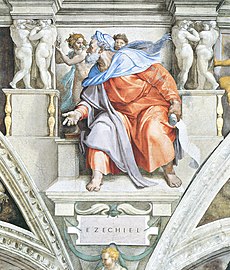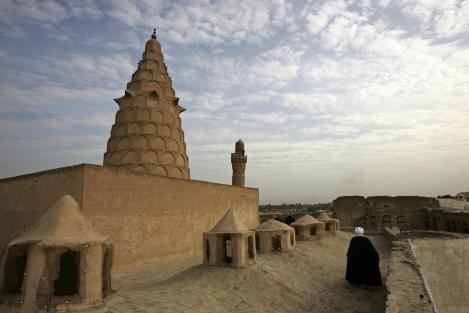 |
| Depiction of Ezekiel by Michelangelo |
Ezekiel was an ancient prophet who lived during the 6th century B.C.; he was the son of Buzi and descended from Tribe of Levi. He is acknowledged as a prophetic seer in Judaism, Christianity, Islam and the Bahá'í Faith and credited with writing the Book of Ezekiel (found in the Tanakh and Old Testament).
According to biblical tradition, he was born in Jerusalem, but carried off to Babylon [when he was 25 years old] with King Jechoniah II and other notable Judeans during the second invasion of Jerusalem by King Nebuchadnezzar II. He lived a big portion of his life in captivity near the River Chebar. At the age of 30 years, he received his first prophetic vision...
Vision #1 - Destruction of Jerusalem and the Second Jewish Temple
 |
| Destruction of Jerusalem & Herod's Temple |
In Chapters 3 through 9, the Creator called upon the ancient prophet to spread the word of His displeasure with the children of Israel and their imminent downfall if they did not repent of their transgressions.
"Son of man, I have made thee a watchman unto the house of Israel: therefore hear the word at my mouth, and give them warning from me." ~ Ezekiel 3:17
After his celestial encounter with the Creator, he incessantly prophesied even though he met much opposition along the way. The prophet Daniel, who was carried away to Babylon earlier, began his prophetic preaching around 606 B.C., but did not see the fulfillment of his fore-warnings in conjunction with Jerusalem's downfall. However, Ezekiel and Jeremiah (another renowned prophet of this era) personally witnessed the Lord's "day of reckoning" when the Babylonians conquered Jerusalem in 587 B.C., destroying the Holy City and bringing down the Second Jewish Temple (aka: Herod's Temple). It was also during this time era that surrounding nations were threatened with divine punishment, as well.
Vision #2 - Restoration of the land of Israel
| Pre-Raphaelite Holman Hunt lived in Jerusalem and urged Jews to return. By Jennifer Lipman, 2012 |
"And say unto them, Thus saith the Lord God; Behold, I will take the children of Israel from among the heathen, whither they be gone, and will gather them on every side, and bring them into their own land: And I will make them one nation in the land upon the mountains of Israel; and one king shall be king to them all: and they shall be no more two nations, neither shall they be divided into two kingdoms any more at all. ~ Ezekiel 37:21-22
Many modern scholars and theologians contend that Ezekiel's prophecy of the Jews returning to their own land was fulfilled when the state of Israel was mandated and established in 1948 by the United Nations.
Vision #3 - The Millennial Temple (aka: Third Jewish Temple)
 |
| Depiction of Ezekiel's Temple |
In Chapters 38 and 39, Ezekiel was shown a horrendous war known as Gog and Magog.
This battle enlightens mankind that armies from the north and east shall descend upon the land of Israel, but will be overthrown when the Creator protects the descendants of Judah and Israel, once more making the nation a whole kingdom, never to divide again. Some scholars believe it will be during this time that the Third Jewish Temple will be rebuilt. In Chapters 40 through 43, specifics are given on this last and final temple... from precise measurements to interior furnishings.
This battle enlightens mankind that armies from the north and east shall descend upon the land of Israel, but will be overthrown when the Creator protects the descendants of Judah and Israel, once more making the nation a whole kingdom, never to divide again. Some scholars believe it will be during this time that the Third Jewish Temple will be rebuilt. In Chapters 40 through 43, specifics are given on this last and final temple... from precise measurements to interior furnishings.
"And he brought me thither, and, behold, there was a man, whose appearance was like the appearance of brass, with a line of flax in his hand, and a measuring reed; and he stood in the gate. And the man said unto me, Son of man, behold with thine eyes, and hear with thine ears, and set thine heart upon all that I shall shew thee; for to the intent that I might shew them unto thee art thou brought hither: declare all that thou seest to the house of Israel." ~ Ezekiel 40:3-4
Ezekiel was 50 years old when he had visions of this new temple. Chapters 44 through 47 basically informs the reader who is allowed in the Holy Temple of God (aka: Ezekiel's Temple) and in-depth instructions given to those who are allowed inside the hallowed halls. From ministering, offerings and sacrificing to which holy gate a person is suppose to use when entering Ezekiel's Temple, the Creator was very extreme in his description of what He expects. Chapter 48 explains how the Creator will divide the Holy Land among the 12 tribes of Israel.
"This is the land which ye shall divide by lot unto the tribes of Israel for inheritance, and these are their portions, saith the Lord God." ~ Ezekiel 48:29
^*^*^*^*^*^*^*^*^*^*^*^*^*^*^*^*^*^*^*^*^*^*^*^*^*^*^
There are many similarities between Ezekiel's visions and those of John of Patmos (aka: John the Evangelist) in the Book of Revelation. The following is a list of those similarities...
| THE VISION | EZEKIEL | REVELATION |
| 1. The Throne Vision | Chapter 1 | Chapter 4 |
| 2. The Book Being Opened | Chapters 2-3 | Chapter 5 |
| 3. The Four Plagues | Chapter 5 | Chapter 6:1-8 |
| 4. Those Slain Under the Altar | Chapter 6 | Chapter 6:9-11 |
| 5. The Wrath of God | Chapter 7 | Chapter 6:12-17 |
| 6. The Seal on the Saint's Foreheads | Chapter 9 | Chapter 7 |
| 7. The Coals from the Altar | Chapter 10 | Chapter 8 |
| 8. The 1/3 Destruction | Chapter 5:1-4; 12 | Chapter 8:6-12 |
| 9. No More Delay | Chapter 12 | Chapter 10:1-7 |
| 10. The Eating of the Book | Chapter 2 | Chapter 10:8-11 |
| 11. Prophecy against the Nations | Chapters 25-32 | Chapter 10:11 |
| 12. The Measuring of the Temple | Chapters 40-43 | Chapter 11:1-2 |
| 13. Comparing Jerusalem to Sodom | Chapter 16 | Chapter 11:8 |
| 14. The Cup of Wrath | Chapter 23 | Chapter 14 |
| 15. The Vine of the Land | Chapter 15 | Chapter 14:18-20 |
| 16. The Great Harlot | Chapters 16, 23 | Chapters 17-18 |
| 17. The Lament Sung Over the City | Chapter 27 | Chapter 18 |
| 18. The Scavenger's Feast | Chapter 39 | Chapter 19 |
| 19. The First Resurrection | Chapter 37 | Chapter 20:4-6 |
| 20. The Battle of Gog and Magog | Chapter 38-39 | Chapter 20:7-9 |
| 21. The New Jerusalem | Chapters 40-48 | Chapter 21 |
| 22. The River of Life | Chapter 47 |
Chapter 22
|
 |
| Ezekiel's Tomb |
The Prophet Ezekiel not only correctly predicted the destruction of Jerusalem and Herod's Temple, but announced a future redemption for the children of Israel before the great Millennial Age is ushered in by their long awaited Messiah.
While the date of the ancient prophet's death was not recorded in the Tanakh/Old Testament, the majority of scholars believe his tomb is located near Baghdad, at a place known as Al Kifl, Iraq.
In our modern world, the Book of Ezekiel is one of the greatest prophetic works in the Hebrew and Christian Bibles. The Qur'an mentions a prophet named Zul-Kifl, who is sometimes identified and compared with Ezekiel, although some Islamic scholars dispute this claim. Regardless, the ancient prophet's insights provide a magnificent picture of what the future holds in store for mankind.
The concept of Ezekiel's message is simple: "...if a righteous man chooses to sin, he shall die for his sin, and his righteousness will not be remembered. If a sinner repents of his transgressions, as well as keep God's commandments, he will not die." (Ezekiel 3:20;18:21-24)
No comments:
Post a Comment